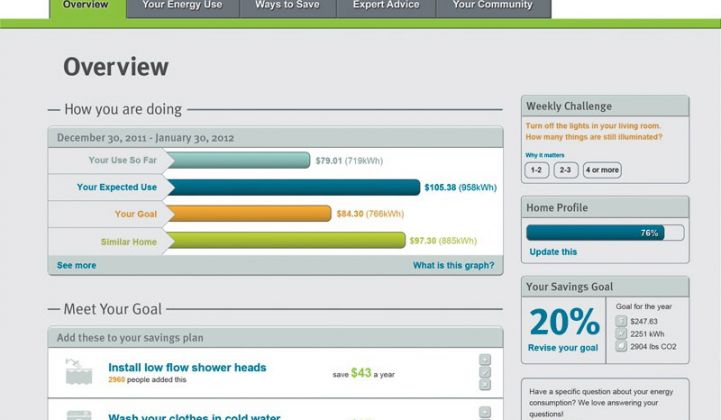Is Tendril ready to take its utility-to-home energy software to commercial scale? On Friday, the startup closed a $25 million round to boost its home energy report software, perhaps as a precursor to fulfilling CEO Adrian Tuck’s promise last year of taking at least a few of the dozens of utilities it’s working with from pilot stage to full-blown deployment in the coming year.
The new investment, part of a previously reported $13.7 million raise earlier this year, brings total VC cash raised by Tendril to about $100 million. Investors include VantagePoint Venture Partners, Good Energies, RRE Ventures, General Electric and Siemens -- the latter two being potential strategic partners, as well.
As for how the startup plans to spend it, spokeswoman Sheila O’Neill told local newspaper the Daily Camera that the investment would be directed at developing Tendril’s home energy reports and its software development platform.
Let’s take the last one first. Tendril has been spending a lot of time opening its energy-utility smart grid software platform to third-party application developers. Its most recent utility customer, Dutch retail energy provider Essent, wants to lure developers as part of a pilot that could expand to about 2 million customers. Tendril has also been working on the U.S. Green Button standard for home energy data.
As for home energy reports, the term applies to the simplest of many features Tendril can turn on for its utility customers: a simple e-document that shows customers’ detailed energy usage data, along with tips for saving power. Tendril’s O’Neill told the Daily Camera that its utility “customers are moving from smaller pilot deployments to larger deployments," driving the need for investment in that area.
Spending money on such seemingly low-tech solutions to energy efficiency is in line with a general trend in the utility industry toward cheaper ways to connect customers to the smart grid. Arlington, Va.-based startup Opower has had great success signing up utilities for its home energy behavior-nudging report systems, which come in the U.S. mail as well as via emails, texts and web dashboards.
And Efficiency 2.0, a startup that gets utility customers to save energy via online coupon giveaways, was just acquired by C3, the well-funded efficiency and sustainability software startup. Both companies claim that a big part of their success comes from advanced analytics capabilities, combined with behavioral science that helps maximize customer participation.
Tendril has also been beefing up its behavioral analytics, buying software developer GroundedPower in 2010 to add it to its customer interface. In February, it bought Recurve Software, a home energy performance software developer, for an undisclosed sum.
Tendril also offers load control, demand response, electric vehicle charging and distributed generation support software, all running on its cloud-based software platform. Tendril has more than 1 million homes now connected, and tens of millions of meters to potentially connect to, via utility customers including San Diego Gas & Electric, Southern California Edison, ConEd, ComEd, National Grid, NSTAR, Ameren, Reliant, WE Energies and a host of smaller municipal utilities.
All of these projects are in pre-commercial stages, however, and the financial case for scaling them up is hard to make. Tendril has joined a host of home energy management competitors -- Silver Spring Networks, Energate, Honeywell, EnergyHub, EcoFactor and many more -- in claiming that a combination of data and technology can yield 20-percent to 30-percent reductions in energy use.
The problem is, real-time energy monitoring and management requires either a smart meter or a home broadband connection with in-home sensors and control systems, and sometimes both. That costs hundreds of dollars.
But consumers have shown they’re unwilling to pay much more than $50 for home energy management, if they’re willing to spend anything at all for reducing such a small part of overall household expenses. A recent survey found that only 13 percent of Americans want an energy dashboard in the home.



